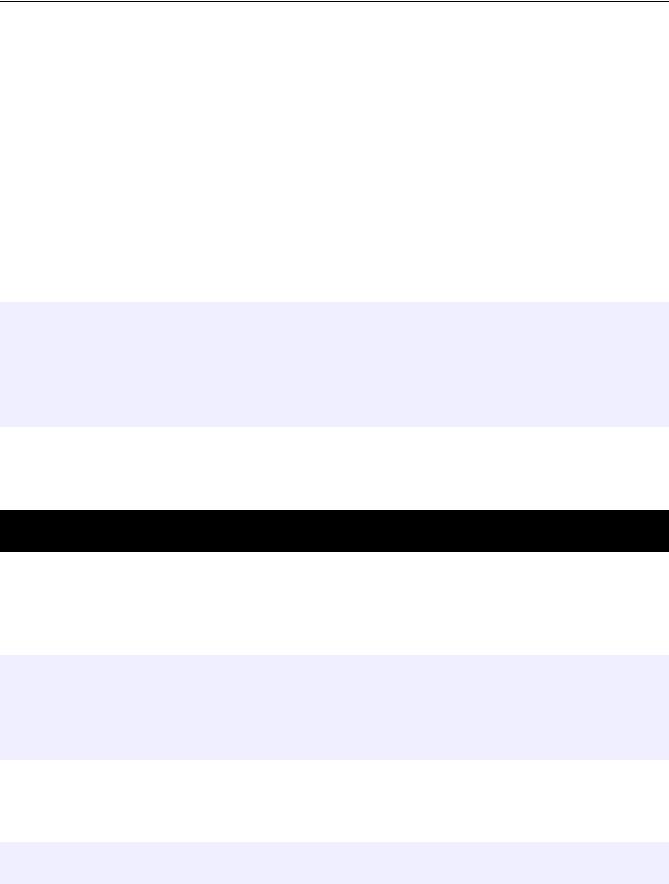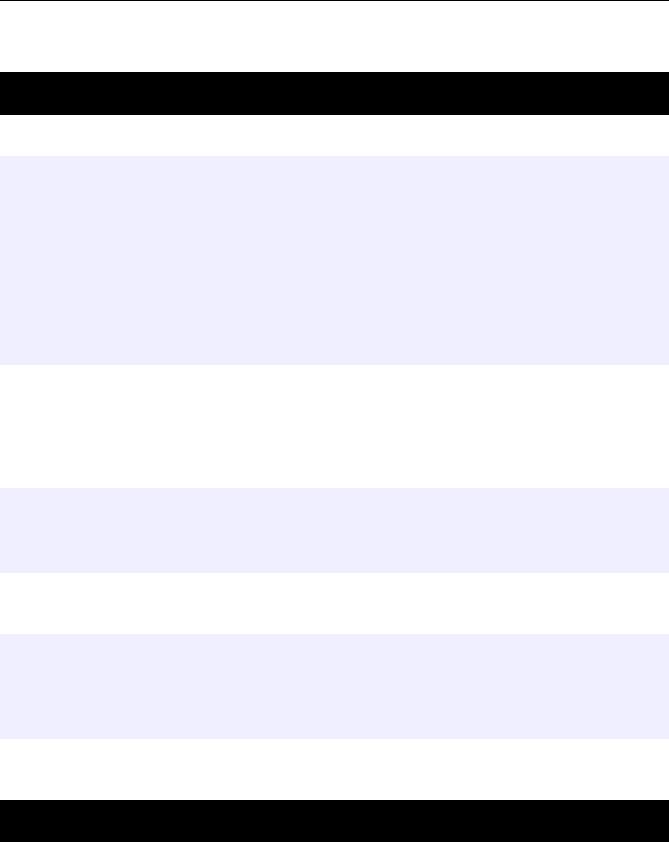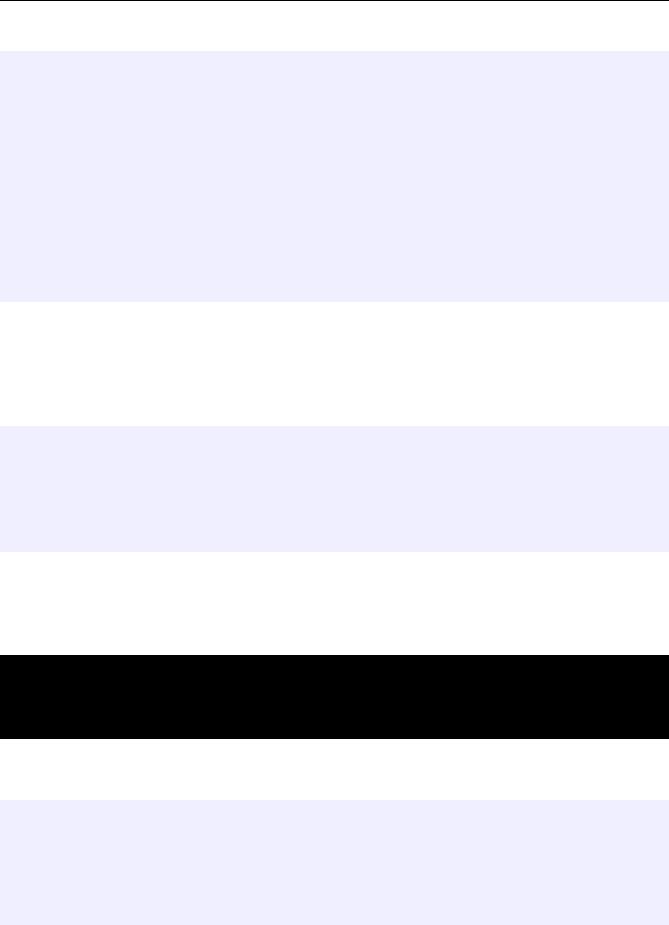
- •Foreword
- •About Programmer’s Heaven
- •About Faraz Rasheed
- •Contents In Summary
- •Tools of the trade
- •The C# Language
- •The .Net Architecture and .Net Framework
- •The Common Language Runtime (CLR)
- •MSIL (Microsoft Intermediate Language) Code
- •Just In Time Compilers (JITers)
- •The Framework Class Library (FCL)
- •The Common Language Specification (CLS)
- •The Common Type System (CTS)
- •Garbage Collection (GC)
- •The .Net Framework
- •C# compared to C++
- •The Visual Studio.Net IDE
- •Projects and Solutions
- •Toolbox, Properties and Class View Tabs
- •Writing Your First Hello World Console Application in C#
- •Working Without Visual Studio.Net
- •With Visual Studio.Net
- •Understanding the Hello World Application Code:
- •Namespaces in C#
- •The using Keyword
- •The class Keyword
- •The Main() Method
- •Printing on the Console
- •Comments
- •Important points to remember
- •A more interactive Hello World Application
- •Discussing a more interactive Hello World Application
- •2. C# Language Fundamentals
- •Lesson Plan
- •Basic Data Types and their mapping to CTS (Common Type System)
- •Integral Types
- •Floating Point Types
- •Other Types
- •Variables
- •Constant Variables or Symbols
- •Naming Conventions for variables and methods
- •Operators in C#
- •Arithmetic Operators
- •Operand
- •Prefix and Postfix notation
- •Assignment Operators
- •Operand
- •Relational Operators
- •Operand
- •Operand
- •Other Operators
- •Operand
- •Operator Precedence
- •Flow Control And Conditional Statements
- •The if...else statement
- •The switch...case statement
- •Loops In C#
- •The for Loop
- •Some important points about the for loop
- •The do...while Loop
- •while Loop
- •Arrays in C#
- •Array Declaration
- •Accessing the values stored in an array
- •foreach Loop
- •3. Classes and Objects
- •Lesson Plan
- •Concept of a Class
- •Objects
- •Fields
- •Data Type
- •Methods
- •Instantiating the class
- •Accessing the members of a class
- •Access Modifiers or Accessibility Levels
- •Access Modifier
- •Properties
- •Using Properties
- •Precautions when using properties
- •Static Members of the class
- •Some More about Methods
- •Constructors
- •Finalize() Method of Object class
- •Destructors
- •Method and Constructor Overloading
- •Overloading Constructors
- •Value types (out & ref Keywords)
- •Reference types
- •Some more about references and objects
- •4. Inheritance & Polymorphism
- •Lesson Plan
- •Inheritance
- •Inheritance in C#
- •Implementing inheritance in C#
- •Constructor calls in Inheritance
- •The base keyword - Calling Constructors of the base-class explicitly
- •Protected Access Modifier
- •The Protected internal Access Modifier
- •The sealed keyword
- •Object class - the base of all classes
- •Polymorphism
- •Using the reference of the base type for referencing the objects of child types
- •Using methods with the same name in the Base and the Sub-class
- •Overriding the methods - virtual and override keywords
- •The new keyword
- •Type casting the objects - Up-casting and Down-casting
- •The is and as keywords
- •Boxing and Un-boxing
- •5. Structures, Enumeration, Garbage Collection & Nested Classes
- •Lesson Plan
- •Structures (struct)
- •Defining a struct
- •Instantiating the struct
- •structs as Value Types
- •Enumeration
- •The Need for Enumeration
- •Using Enumeration (enum)
- •More about Enumerations
- •Garbage Collection in .Net
- •Destructors and Performance Overhead
- •System.GC.Collect() method
- •Nested Classes in C#
- •6. Abstract Classes & Interfaces
- •Lesson Plan
- •Abstract Classes
- •Interfaces
- •Implementing More Than One Interface
- •Explicit implementation of methods
- •Casting to an interface using is and as operators
- •An interface inheriting one or more interfaces
- •7. Arrays, Collections & String Manipulation
- •Lesson Plan
- •Arrays Revisited
- •Multidimensional Arrays
- •Instantiating and accessing the elements of multidimensional arrays
- •Instantiating and accessing Jagged Arrays
- •Some other important points about multidimensional arrays
- •The foreach Loop
- •Collections
- •The ArrayList class
- •The Stack class
- •The Queue class
- •Dictionaries
- •The Hashtable class
- •Constructing a Hashtable
- •Adding items to a Hashtable
- •Retrieving items from the Hashtable
- •Removing a particular item
- •Getting the collection of keys and values
- •Checking for the existence of a particular item in a hashtable
- •The SortedList class
- •String Handling in C#
- •The string class and its members
- •The StringBuilder class
- •8. Exception Handling
- •Lesson Plan
- •Exceptions Basics
- •The need for Exceptions
- •Exceptions in C# and .Net
- •Handling Exceptions using the try...catch...finally blocks
- •Use of the try...catch block
- •Exception class' Message and StackTrace Properties
- •The finally block
- •Catching Multiple Exceptions using multiple catch blocks
- •An important point to remember in multiple catch blocks
- •Other important points about Exception Handling in C#
- •Defining your own custom exceptions
- •Exception Hierarchy in the .Net Framework
- •Throwing an exception: the throw keyword
- •9. Delegates & Events
- •Lesson Plan
- •Delegates Basics
- •The type or signature of the method the delegate can point to
- •The delegate reference, that can be used to reference a method
- •3.The actual method referenced by the delegate
- •Calling the actual method through its delegate
- •Confusion in terminology
- •Delegates in the .Net Framework
- •Passing delegates to methods
- •Multicast Delegates
- •Implementing a Multicast Delegate
- •Removing a method from the multicast delegate's invocation list
- •Events and Event Handling
- •Event Handling in C#
- •A Clock Timer Example
- •Multicast events
- •Passing some data with the Event: Sub-classing System.EventArgs
- •10. WinForms & Windows Applications
- •Lesson Plan
- •Windows Applications and .Net
- •WinForm Basics
- •Building the "Hello WinForm" Application
- •Understanding the Code
- •Adding Event Handling
- •Visual Studio.Net & its IDE (Integrated Development Environment)
- •IntelliSense and Hot Compiler
- •Code Folding
- •Integrated Compiler, Solution builder and Debugger
- •Form Designer
- •Solution Explorer
- •Menus in the Visual Studio .Net IDE
- •Using Visual Studio.Net to build the "Hello WinForm" Application
- •Creating a new Project
- •Setting various properties of the form
- •Adding Controls to the Form
- •Adding Event Handling
- •Executing the application
- •The code generated by the Form Designer
- •Using More Controls
- •Using various controls in an application: Programmer's Shopping Cart
- •Designing the form and placing the controls
- •Writing Code for Event Handling
- •Some Important Points for designing Windows Applications
- •11. More Windows Controls & Standard Dialog Boxes
- •Lesson Plan
- •Collection Controls
- •List Box Control
- •Adding items to the list box
- •Accessing items in the list box
- •Removing items from the list box
- •List Box Events
- •Combo Box Control
- •Tree View
- •The TreeNode Editor
- •Adding/Removing items at runtime
- •Tree View Events
- •Image List Control
- •Attaching An Image List to different controls
- •List View Control
- •Two Image Lists in the List View Control
- •Adding items to the list view control using designer
- •Adding Items at runtime using code
- •Events for List View Control
- •Main Menu
- •Tool Bar
- •Date Time Picker
- •Windows Standard Dialog Boxes
- •Open File Dialog Box
- •Using the Open File Dialog Box
- •Save File Dialog Box
- •Font and Color Dialog Boxes
- •12. Data Access using ADO.Net
- •Lesson Plan
- •Introducing ADO.Net
- •Different components of ADO.Net
- •A review of basic SQL queries
- •SQL SELECT Statement
- •SQL INSERT Statement
- •SQL UPDATE Statement
- •SQL DELETE Statement
- •Performing common data access tasks with ADO.Net
- •Accessing Data using ADO.Net
- •Defining the connection string
- •Defining a Connection
- •Defining the command or command string
- •Defining the Data Adapter
- •Creating and filling the DataSet
- •A Demonstration Application
- •Loading tables
- •Filling the controls on the Form
- •Navigating through the records
- •Updating the table
- •Building the Application
- •Loading the table and displaying data in the form's controls
- •Initialing Commands
- •Adding Parameters to the commands
- •The ToggleControls() method of our application
- •Editing (or Updating) Records
- •Event Handler for the Save Button
- •Event Handler for the Cancel Button
- •Inserting Records
- •Deleting a Record
- •Using Stored Procedures
- •Sample Stored Procedures
- •UPDATE Stored Procedure
- •INSERT Stored Procedure
- •DELETE Stored Procedure
- •SELECT Stored Procedure
- •Using Stored Procedures with ADO.Net in C#
- •The modified InitializeCommands() method
- •Using Data Grid Control to View .Net data
- •A Demonstration Application for Data Grid Control
- •Second Demonstration - Using multiple related tables
- •Retrieving data using the SELECT command
- •Updating Records using INSERT, UPDATE and DELETE commands
- •13. Multithreading
- •Lesson Plan
- •What is Multithreading
- •Multithreading in C#
- •Thread Functionality
- •Static members of the System.Threading.Thread class
- •Instance members of the System.Threaing.Thread class
- •Thread Demonstration Example - Basic Operations
- •Thread Demonstration Example - Thread Priority
- •Thread Demonstration Example - Thread Execution Control
- •Using Join() to wait for running threads
- •Thread Synchronization
- •The C# Locking Mechanism
- •Threads may cause Deadlock
- •14. The File System & Streams
- •Lesson Plan
- •Working with the File System
- •Obtaining the Application’s Environment Information – The System.Environment class
- •Demonstration Application – Environment Information
- •Obtaining the paths of various Windows Standard folders – Environment.GetFolderPath()
- •Manipulating Files using System.IO.File and System.IO.FileInfo classes
- •System.IO.File class
- •Creating a file using Create() method
- •Copying and Moving a file using Copy() and Move() methods
- •Checking the existence of the file using Exists() method
- •Getting Attributes of a file using GetAttributes() method
- •System.IO.FileInfo class
- •A quick and simple example
- •Manipulating Directories (folders) using System.IO.Directory and System.IO.DirectoryInfo classes
- •System.IO.Directory class
- •Creating, deleting and checking for the existence of directories
- •Getting the contents (files and sub-directories) of a directory
- •System.IO.DirectoryInfo class
- •Demonstration application for the DirectoryInfo class
- •Streams
- •An overview of the different types of streams
- •The System.Stream class – the base of all streams in the .Net framework
- •Different types of file streams – Reading and Writing to files
- •Using System.IO.FileStream to read and write data to files
- •A string representing the path and name of the file
- •Opening and reading from a file
- •Using BinaryReader and BinaryWriter to read and write primitives to files
- •Using StreamReader and StreamWriter to read and write text files
- •Serialization and De-serialization
- •Implementing Serialization and Deserialization – A simple example
- •Formatters in Serialization
- •Preventing certain elements from Serializing – The [NonSerialized] attribute
- •Getting notified when Deserializing - the IDeserializationCallBack interface
- •Asynchronous Reading and Writing with Streams
- •A demonstration application
- •Issues Regarding Asynchronous Read/Write
- •Important points regarding the use of Streams
- •15. New Features In C# 2.0
- •C# evolves
- •The need for generics
- •Generic collections
- •Creating generic types
- •Constraining type parameters
- •Final thoughts on generics
- •Partial types
- •Nullable types
- •Anonymous methods in event handling
- •Adventures with anonymous methods
- •Final thoughts on C# 2.0
- •16. The Road Ahead
- •Learning More
- •Getting Help
- •Book.revision++
- •Good Luck!

Programmers Heaven: C# School
In a similar manner, you can define many useful enumerations like days of the week (Sunday, Monday,…), name of the months (January, February,…), connection type (TCPIP, UDP), file open mode (ReadOnly, WriteOnly, ReadWrite, Append), etc.
More about Enumerations
Enumerations internally use integral values to represent the different named constants. The underlying type of an enumeration can be any integral type (e.g. int, byte, etc). The default type is int. In fact, when we declare an enumeration, its items are assigned successive integer values starting from zero. Hence, in our SortCriteria enumeration, the value of ByName is 0, the value of ByType is 1, the value of BySize is 2 and the value of ByDate is 3. We can convert the Enumeration data back to an integral value by applying an appropriate cast.
static void Main()
{
SortCriteria criteria = SortCriteria.ByType;
int i = (int) criteria;
Console.WriteLine("the integral value of {0} is {1}", criteria, i);
}
Here, we created an instance of SortCriteria (named criteria), type-casted it to int and then printed it using the Console.WriteLine() method. The output is:
the integral value of ByType is 1
Press any key to continue
You can see from the output that the integral value of SortCriteria.ByType is 1. Also note that when we printed the enumeration identifier (criteria), it printed the named constant (ByType) and not its value (1). We can also define the values for the Enumerator identifier explicitly while defining new enumerations, like:
enum Temperature
{
BoilingPoint = 100,
FreezingPoint = 0
}
Now, when we try to print the value of either Temperature.BolingPoint or Temperature.FreezingPoint, it will display the assigned values and not the default values (starting from zero and incrementing by one each time).
int i = (int) Temperature.BoilingPoint;
Console.WriteLine("the integral value of {0} is {1}", Temperature.BoilingPoint, i);
Will display:
108

Programmers Heaven: C# School
the integral value of BoilingPoint is 100
Press any key to continue
Consider the following enumeration
enum Days : byte
{
Monday = 1,
Tuesday,
Wednesday,
Thursday,
Friday,
Saturday,
Sunday
}
Here we have defined an enumeration for Days. Note that we assigned the value of 1 to Monday. Hence, the integral values for successive constants would be successive integers after 1 (that is, 2 for Tuesday, 3 for Wednesday and so on). Also, note that we specified the underlying type for the enumeration (Days) as a byte instead of the default int type. Now, the compiler will use the byte type to represent days internally.
enum Days : byte
{
...
}
In the Main() method, we can print the integral value of days as:
static void Main()
{
int i = (byte) Days.Tuesday;
Console.WriteLine("the integral value of {0} is {1}", Days.Tuesday, i);
}
The output is:
the integral value of Tuesday is 2
Press any key to continue
Finally, enumerations are of value type. They are created and stored on the stack and passed to the methods by making a copy of the value (by value).
109

Programmers Heaven: C# School
Garbage Collection in .Net
Memory management is no longer the responsibility of a programmer when writing managed code in the .Net environment. .Net provides its own Garbage Collector to manage the memory. The Garbage Collector is a program that runs in the background as a low-priority thread and keeps track of the un-referenced objects (objects that are no longer referenced by any reference) by marking them as 'dirty objects'. The Garbage collector is invoked by the
.Net Runtime at regular intervals and removes the dirty objects from memory.
Before re-claiming the memory of any object (before removing the object from memory), the garbage collector calls the Finalize() method or destructor (discussed in lesson 4) of the object, so as to allow an object to free its resources. Hence, you should provide the destructor (which internally overrides the Object class' Finalize() method) in your classes if you want to free some un-managed resources held by your objects. Since the Finalize() method is called by the Garbage Collector before re-claiming the object's memory, we never know exactly when it will be called. It may be called instantly, after an object is found to have no references to it, or later, when the CLR needs to re-claim some memory. You may optionally implement the IDisposable interface and override its Dispose() method if you want to allow the user of your class to specify (by calling the Dispose() method) when the resources occupied by the object should be freed. Although we haven't yet discussed interfaces, I will give an example of implementing the IDisposable interface, as you will have to use this method quite often in your programs. I recommend that you come back and read this again after you become familiar with interfaces.
using System;
namespace CSharpSchool
{
class Test
{
static void Main()
{
GarbageCollection garCol = new GarbageCollection(); garCol.DoSomething();
garCol.Dispose();
}
}
class GarbageCollection : IDisposable
{
public void DoSomething()
{
Console.WriteLine("Performing usual tasks...");
}
public void Dispose()
{
GC.SuppressFinalize(this);
110

Programmers Heaven: C# School
Console.WriteLine("Disposing object...");
Console.WriteLine("Freeing resources captured by this object...");
}
~GarbageCollection()
{
Console.WriteLine("Destructing object...");
Console.WriteLine("Freeing resources captured by this object...");
}
}
}
In the above example we have declared a class named GarbageCollection which implements the IDisposable interface and overrides its Dispose() method. Now, the user or client of the GrabageCollection class can decide when to free-up the resources held by the object, by calling the Dispose() method. The common usage of the class is demonstrated in the Test class' Main() method. Note that we called the SuppressFinalize() method of the System.GC class in the Dispose() method.
public void Dispose()
{
GC.SuppressFinalize(this);
Console.WriteLine("Disposing object...");
Console.WriteLine("Freeing resources captured by this object...");
}
The System.GC class can be used to control the Garbage Collector. If we pass the current object in the GC.SuppressFinalize() method, the Finalize() method (or destructor) of the current object won't be called. If we execute the above program, we will get the following output:
Performing usual tasks...
Disposing object...
Freeing resources captured by this object...
Press any key to continue
But, if we comment out the call to the Dispose() method in our Main() method.
static void Main()
{
GarbageCollection garCol = new GarbageCollection(); garCol.DoSomething();
//garCol.Dispose();
}
111
